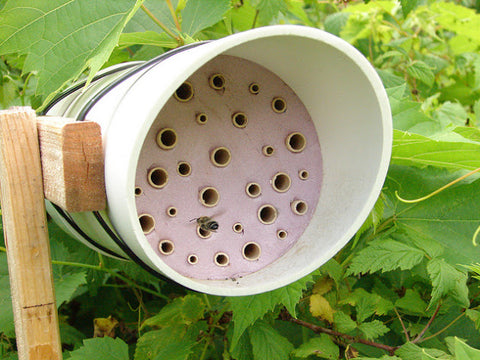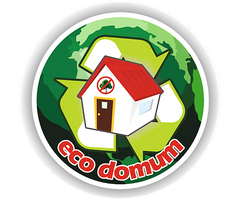- Continue Shopping
- Your Cart is Empty
Plastic Waste Helping Impoverished Families Afford Housing
Plastic. We know it's not good for the environment, but it's almost impossible to escape it. Even as we take steps to reduce the amount of plastic that we use, millions of pounds of plastic end up in landfills worldwide every year. Now, a company has found a unique use for some of that plastic, and there is a chance that it could solve another major problem facing the world--a lack of affordable housing.
EcoDomum is a startup business that creates a building material out of plastic waste. To create the material, the company seeks out used plastic waste from different sources. The plastic items are carefully inspected to select items that will not give off harmful fumes when they are melted. Items like soda bottles and children's toys are among some of the most frequently used plastics.
image source: http://www.ecodomum.mx
Once the plastics have been selected, they are melted in an oven that reaches a temperature of over 600 degrees Fahrenheit. It takes about 30 minutes for the plastic to complete liquefy, at which point it is put through a hydraulic press that flattens the plastic into panels. These sturdy panels measures 8 feet in length by 4 feet in width by 1 inch in thickness, and EcoDomum can make 120 of them every day. One day's production uses 5.5 tons of plastic waste.
With only 80 panels, EcoDomum's building materials can be used to build one house. The company has partnered with a subsidized housing program in Mexico to build houses for impoverished families. In some cases, families are able to receive a brand new 430 square foot house by paying only around $280.
The prospects of what EcoDomum's building material could mean both for the planet and for society are amazing. Hopefully, the start-up will take off and be able to increase production to begin helping families elsewhere in the near future.
Bees Make the Best of Plastic Waste
Plastic waste is impacting the eco system of many organisms around the globe, and if you want to see proof of that, you might not need to look any further than a bee's nest.
A new study conducted jointly by the York University and the University of Guelph reveals that bees have begun to use plastic waste as a material for their hives. The team examined the hive-building habits of two different species of bees to study their behaviors.
One species the alfalfa leafcutter bee typically builds nests solely out of leaves, but the study showed that now up to 23 percent of the hives built by the bees were made of thin plastic bag waste. The scientists theorized that since more and more natural habitats are being replaced by urban sprawl, the bees are incorporating plastics to compensate for fewer readily available leaves.
While this may seem like good news--that the bees are able to adapt to our pollution--the scientists point out that the plastic is not as sturdy as the leaves. Though the bee larvae was able to be raised inside the hive, the nests were not as strong.

Which Bag Wins in a Game of Paper, Plastic or Cloth?
Last month, we discussed a debate that's raging in Russia over whether it's better to ban paper bags in favor of paper bags or continue using plastic. The story got me to thinking about which actually is the most harmful to the environment, and the results really surprised me.
A professor at the University of Oregon, chemist David Tyler extensively studied the use of paper bags, plastic bags and cloth bags, evaluating them from every aspect to disposal. His research examined the environmental impact of all three types of bags. Here are some of the things that he found:
- In terms of carbon footprint or the impact of manufacturing the bags, plastic actually beat out both paper and cloth. The paper bags may not be surprising, but the fact that plastic, which is made from chemicals, had less of an impact than cotton bags astounded me. It turns out that the pesticides used on the cotton plants from which many bags are produced are the problem. The moral of the story is that going organic is the best way to ensure that your reusable cloth bag truly is the best choice for the Earth.
- When it comes to disposal, plastic bags break down the slowest when they reach landfills. Paper breaks down the fastest, while natural cotton fibers fall somewhere in between.
- If you're taking conservation into account, cloth bags win every time. Cotton is a renewable resource, as the plants quickly grow for harvesting each year. Although trees can be regrown, the paper pulp used to create paper is typically not viewed as a renewable product because of the time that it takes for a tree to fully mature. Plastic bags made from petrochemicals are clearly not renewable.
What do you think about these facts? Will it change how you carry your groceries and shopping? Let us know in the "Comments" section.
http://cascade.uoregon.edu/fall2012/expert/expert-article/
Russia Debates: Paper or Plastic?
The Russian Union of Industrialists and Entrepreneurs is currently debating a possible ban on the use of plastic bags throughout shopping malls in Russia. Instead of plastic bags, paper bags would be used in these shopping centers.
The issue is a part of a growing eco consciousness in the country, which has one of the lowest recycling rates in Europe.
Russians have mixed feelings about the potential ban. Roughly 49 percent say that they're in favor of it, believing that plastic waste is a more pressing problem than paper waste. About 32 percent of Russians surveyed are against the proposal, feeling that paper is just as much of a problem. Some even believe that it's the Russian paper industry pushing for the ban. The remainder of Russians felt as if they did not have enough information to decide which was best.
The RUIE does seem to have enough support throughout its membership to pass the ban, despite the mixed sentiments among the Russian people. What's your opinion on this issue? Do you think plastic waste should be minimized even if it means wasting paper? Weigh in in the "Comments" section!

Choosing Safer Toys for Your Kids
Recently, the Huffington Post featured an article describing how fossil fuels are found in many everyday products, particularly those made out of plastics. After reading the article, I got to thinking about the various additives in children's toys. To me, this is one of the scariest places that toxins can lurk as we all know many kids' toys end up in their little mouths, no matter how closely you watch your children.
I did some research to compile a list of some of the most dangerous materials still used in toys. These include:
- Bisphenol-A or BPA
- Phthalates
- Lead and lead-based paints
- Nonylphenol ethoxylate
- Heavy metals like cadmium and mercury
- Arsenic
So how can you tell if a toy is safe? Unfortunately, it's not always simple.
One thing you can look for is organic certification or certification from a well-known organization like Cradle to Cradle. You can also look at the recycling symbols on the bottoms of plastic toys. Those marked #7 are made out of polycarbonate and likely tainted with BPA. #3 plastic is often phthalate-laced PVC. Here at Paperless Kitchen, we have some nontoxic kitchen toys that are a good starting point for choosing safer toys for your kids.

Greening Plastics: Part Three, RPET Products
To finish out our mini “Greening Plastic” series, I thought it was important to highlight one of the new ways that plastic is being reused. In Part One of our series, I touched briefly on some of the ways that green companies are using recycled PET plastic or RPET.
One of the uses I find most incredible is weaving plastic fibers into fabric. The sleek, smooth surface of a soda bottle hardly brings to mind images of carpeting, upholstery or fabric, but numerous companies are now using plastic bottles to produce fibers that can be used for almost any application where synthetic fabrics like polyester might otherwise be employed.
Getting a plastic mouthwash bottle or other PET product into fabric form requires many steps. The plastic has to be washed, dried, crushed into fine pieces, purified, melted and then shaped into thread or fibers. But once the process is finished and the fibers are woven by hand or machine, the RPET fabric is almost indistinguishable from polyester.
In the world of paperless kitchen products, you can find RPET fabric in the sleeves that hold To-Go Ware's innovative bamboo utensil kits. In these kits, the colorful fabric sleeves are used to hold a set of plastic silverware alternatives and are outfitted with a carabiner for easy carrying.
When you're shopping for RPET products, it's important to keep in mind the post-consumer recycled content percentage, which many products provide, even if it’s only in fine print. This is the amount of recycled materials that are actually used in a given product. A product that is made out of 100 percent post-consumer recycled content like the RPET fabric sleeves made by To-Go Ware are made of recycled content, while products with a lower percentage mix recycled content with other materials.
Have a question about RPET products or want to share a great RPET find? Post in our comments!







